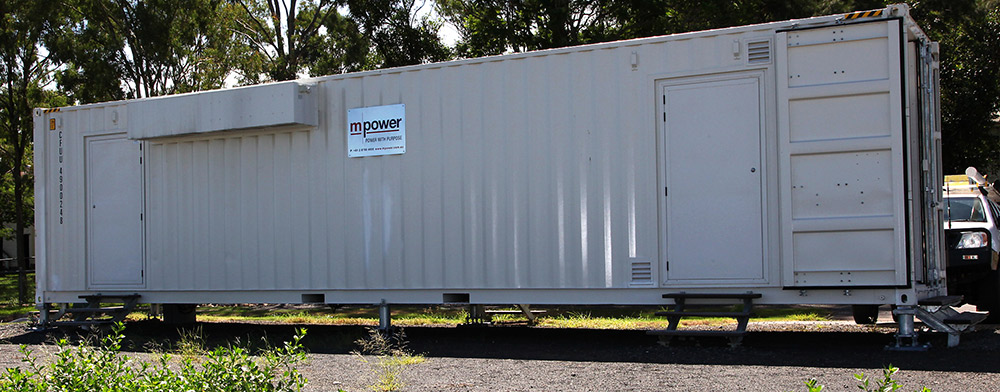Gatton solar research facility battery storage system

A 600 kW, 760 kWh Battery Energy Storage System (BESS) has been integrated with The University of Queensland (UQ) Gatton Solar Research Facility (GSRF).
This addition to the Australian Government funded 3.275 MW pilot PV plant brings a new dimension to UQ’s large-scale PV grid integration research. This document intends to introduce the BESS at UQ Gatton and share some of the aspects considered during the testing and commissioning process to make this facility suitable for research and development on BESS applications for enabling large-scale PV integration.
Technology description
Based on Superior Lithium Polymer Battery (SLPB) technology, the system is composed of two battery banks, each feeding a set of two 300 kVA inverters. One battery bank contains four racks built using 10 series connected modules per rack.
Each of the modules contains two parallel strings of 18 series connected cells. Kokam manufactured SLPB cells are rated at 75 Ah. With a nominal life of 4000 charge-discharge cycles at 80% Depth of Discharge (DoD) and a wide band of operating temperature, the battery cells are expected to sustain and facilitate long-term projects at Gatton ambient conditions.
Recent commissioning tests found the BESS to be promisingly efficient – about 90% for both of the banks. Battery Management Systems (BMS) are integrated at module, rack and bank level that provide critical information on cell performance.
Testing and commissioning with a focus on research potential
Special attention was given to the research potential during acceptance tests at the manufacturer’s facility and at the UQ Gatton site. Precise control of active and reactive power is highly important for testing and validation of new strategies for BESS operation in the context of solar PV integration.
During the commissioning tests, particular emphasis was given to ensure that the actual outputs did not deviate from the set-points significantly. Performance of the BESS over the full range of active and reactive power capability was tested to ensure that extreme operations did not create any issues while pursuing innovative research projects.
Arrangements were made to collect a comprehensive set of feedback signals, process and display those properly to make sure that BESS response to a new control strategy could be accurately understood.
Based on the learning from on-site commissioning, control and protection systems were modified to manage temperature related issues to enable BESS performance and life degradation research at high ambient temperature, which is typical for Gatton during summer season.
Control system integration with research flexibility
The BESS at the UQ Gatton plant is controlled using a Programmable Logic Controller (PLC) that issues commands for BESS operation based on PV array output, campus demand, and other relevant network parameters.
The control system is integrated with the plant Central Supervisory System (CSS) whilst maintaining provision for research project demonstration. BESS control system parameters are organised in an easily programmable manner to use the whole range of capabilities for testing of new BESS operation strategies.
An OPC (Object linking and embedding for Process Control) interface is being set up to create inter-operability options to interface external computing platforms such as MATLAB. This would be useful for fast and easy preparation of field trials to test new and innovative BESS control strategies on a live system.
Bess monitoring and data logging system for analysis and research
BESS electrical, control, and physical (e.g. temperature) parameters are monitored and logged using a Wonderware Historian system integrated with the plant CSS.
A comprehensive set of data containing operational parameters of the PV system, the BESS, and network measurements can be made available from the Historian system which is essential for understanding BESS performance under a certain strategy and to develop new strategies.
Measurements are also accessible by the OPC interfaced computing facilities for on-line and off-line applications.
Research projects
Ongoing/pipeline projects using the BESS at Gatton includes: sensible utilisation of BESS capacity for storing excess PV energy and peak load support; PV smoothing/intermittency mitigation; participation in demand response; managing cycle-life and capacity degradation of BESS due to PV variability; and, thermal management of BESS at non-ideal ambient conditions.
Conclusion
Integration of battery storage at the UQ Gatton Solar Research Facility was one of the greatest and most challenging milestones to achieve in the whole endeavour, and enhances the competency of this world-class PV integration research facility.
UQ Solar anticipates this commercially operating live PV-battery integrated system and state-of-the art research facilities at Gatton and St Lucia campus would be able to attract significant national and international collaborations in solar PV and energy storage research.
